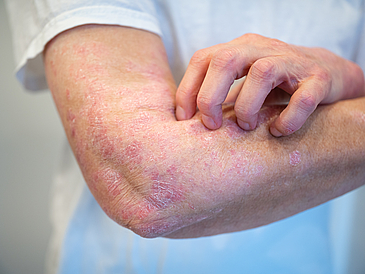AI Facilitates Safe Light Therapy for Chronic Skin Diseases at Home
In Germany, around seven million people suffer from chronic skin diseases such as neurodermatitis and psoriasis. The suffering caused by the disease is high and in many cases treatment with skin creams is not enough. The most gentle and cost-effective way to treat symptoms such as permanent itching is through phototherapy, i.e. by irradiating the affected parts of the body with light.
However, many of those affected cannot integrate this therapy into their everyday lives due to the high time and organizational effort required, so they instead have to resort to medication, some of which cause significant side effects. The start-up Skinuvita, a spin-off from the University of Bremen, is now about to launch a therapy system that can be used easily and safely at home.
A research collaboration with the Technology Center for Computer Science and Information Technology (TZI) at the University of Bremen is now intended to help make operation even easier and more secure against misuse in the future. By using artificial intelligence (AI) methods, the computer graphics working group led by Professor Gabriel Zachmann wants to enable body parts to be automatically recognized and the optimal dosage of light to be ensured.
So far 30 sessions with dermatologists have been required
Until now, the skin has to be irradiated by dermatologists – three to six times a week in a total of 30 sessions during a flare-up of the disease. The actual process only takes between 25 seconds and a maximum of 10 minutes, but the patients have to travel there, wait and return within the opening hours of their practice. This is hardly feasible, especially for people in rural areas, single parents and many working people.
In order to make phototherapy accessible to all those affected, the start-up Skinuvita is currently developing the technology so that it can also be used at home safely and without side effects. The digital therapy system is intended to be the first European solution to meet all guideline requirements for medically supervised home therapy. The system’s components include therapy manager software for doctors, a patient app and a Bluetooth control module for the therapy device.
A decisive change compared to the traditional approach is the digitalization of the currently analog processes. The digital creation of therapy plans enables, among other things, “remote control” of the dosage by dermatologists. Thanks to the Bluetooth control module, manual dose entry is no longer necessary and sufficient time intervals between therapy sessions are ensured. Instead of 30 visits to the doctor’s office, only two are required: once at the beginning and once at the end of therapy. In the meantime, the dermatologists still retain full control.
Automatically detect body parts and skin redness
As part of the joint research project, Professor Zachmann’s TZI working group is now developing automated image analysis methods to facilitate the safe use of the device. One goal, for example, is the automatic recognition of body parts. In this way, the system can prevent the wrong area from being treated or the right area from being irradiated twice. Measuring the correct distance between the lamp and the skin is also important.
It is also conceivable to develop LED lights that automatically only illuminate important points and not the entire body part. Another task for which the use of AI is suitable is the precise detection and classification of skin redness. “So far, users have assessed for themselves what their skin looks like,” reports Judith Boeckers, research associate in the TZI computer graphics working group. “But what is an intense red for one person is pale for another.” This is also not easy for the treating doctors to distinguish in the photos submitted because the photos are often lit differently. AI can help with image processing and color matching.
“We would like to think further about how we can make medical care even better with the help of intelligent data use,” adds Skinuvita CEO Jan Elsner. A central question: “How can we use the technologies on smartphones to make treatment more effective?”
The product development of the first version of the system is now almost complete – the results of the research project will be incorporated into further development. A clinical study in which more than 600 therapy sessions have already been completed has so far revealed no safety problems. “As expected, treatment adherence is higher than if people had to drive to the practice,” reports Elsner. “More patients are completing the therapy without stopping. At the same time, the quality of life increases significantly.” The approval process is now nearing completion, so the system could be on the market in the fall.
The state of Bremen supports the research cooperation between the university and Skinovita as part of the “Promotion of Research, Development and Innovation” (FEI) program.

